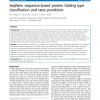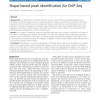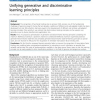697 search results - page 97 / 140 » Improving EAs for Sequencing Problems |
NAACL
2003
13 years 10 months ago
2003
Automatic restoration of punctuation from unpunctuated text has application in improving the fluency and applicability of speech recognition systems. We explore the possibility t...
BMCBI
2010
13 years 9 months ago
2010
Background: Protein folding rate is an important property of a protein. Predicting protein folding rate is useful for understanding protein folding process and guiding protein des...
BMCBI
2006
13 years 9 months ago
2006
Background: We describe Distill, a suite of servers for the prediction of protein structural features: secondary structure; relative solvent accessibility; contact density; backbo...
BMCBI
2011
13 years 4 months ago
2011
Background: The identification of binding targets for proteins using ChIP-Seq has gained popularity as an alternative to ChIP-chip. Sequencing can, in principle, eliminate artifac...
BMCBI
2010
13 years 9 months ago
2010
Background: The recognition of functional binding sites in genomic DNA remains one of the fundamental challenges of genome research. During the last decades, a plethora of differe...



